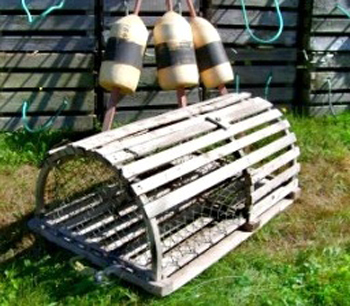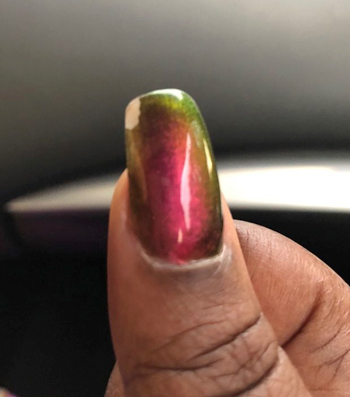O U T H E R E I N T H E R E A L W O R L D
Fred’s Lobster Operation
Some fuzzy memories of dinner pails, trap nails,
and CB radio
by Eva Murray

Wood lobster trap of nearly “yore” fastened with trap nails.
Etsy, one of the jillion or so online mechanisms provided for us so that we may more easily buy stuff, has used lobster traps for sale. The old-style wooden trap is categorized as “An item that has been used previously” and as “vintage.” It is also categorized as “$99.99.” The trap is described as somewhat beat up but “Great decor for a seafood restaurant or a beach house.” Did I say, “$99.99?” Uh huh.
You can be sure that I was not online visiting used lobster-trap emporia out of any desire to order an old lobster trap in the mail, but stumbling into it did get me thinking about the days of wooden traps, and brought back some memories of my grandfather lobstering when I was a kid in the 1970s. I thought, with the Fishermen’s Forum and everything, a few images from those days might be enjoyable.
Again, I was a kid, and not paying very much attention to taking notes on my grandfather Fred’s fishing business. He just took his lunch, which my grandmother Mabel was responsible for assembling, and went to haul. If I was even awake yet, which wasn’t often, I was busy sharing a loaf of white toast with my cousin’s backyard ducks.
Sometime when I was a fairly small kid, I do not recall exactly when, Fred went to Canada and came home towing a Novi boat hull. I remember it coming down the road and then being parked near the Waterman Beach Road beside his shop. He still had to build the house and add a lot to it. Jimmy and Ben and I, and quite possibly Brian, or Diana from next door, crawled around all over and explored it.
“Barshtid” was his
all-purpose word,
casually replacing
most any noun.
He named his new boat the Chub, which he claimed was his mother’s nickname. His mother was still alive and living in Spruce Head, and if I’d been her I’d have slapped him for that. He also painted it bright yellow. That was a big deal, because in those days, colorful lobster boat hulls were rare. Normal lobster boats, at least around here, were white. His boat was never the biggest, or the fastest, or the sharpest looking, and not the cleanest either, but it was definitely the most colorful boat in South Thomaston.
To elementary school-aged me the yellow hull was original, and cool, but “Chub” was inexplicable.
His previous boat had been the Eleanor, named for his daughter (my mom) who fished with him well before my time. I don’t have any real recollection of the Eleanor except remnants of the stern with the name. I heard that when he burned the old Eleanor at the end, that transom or name-board would not burn. After that, most people would have hung it on a wall somewhere (he didn’t).
Fred worked alone. We kids could go along once in a while in the summertime, but he didn’t need us underfoot. Mostly he let us jig for mackerel. We caught pollock, which we didn’t like, and dogfish, which we couldn’t handle. My brother caught an Atlantic saltwater salmon once on a string-and-stick arrangement, which got Fred all excited. He said he’d been hoping to catch one for years, and then here comes this little five-year-old with the merest hook and line.
The neat part was the idea that Freddie could sit at his kitchen table and watch his yellow boat swinging on her mooring in the cove at the bottom of the hill. Around the table, usually, were Ashley and Jack and Carl and sometimes others. On one side of the cove, a point of land occupied by “German Joe” and his wife and a mess of sheep which sometimes got loose; on the other, a point of land occupied by the extended Waterman family for which the whole road was named, including the large open field which Mary Waterman valiantly defended (that story is about a pair of young tourists thinking her lovely seaside hayfield an inviting place to roll around a little in the altogether, until Mary fires off one or two of those seal loads from up at the house—blanks, intended just for noise—over them. The amorous strangers were forced to leap up in a panic, grab their clothes and, they assumed, run for their lives. “I was trying to get a crop of hay off that field and they were knocking it down!” insisted Mary in her own defense. I think she was on the school board at the time.)

Trap nail as described on the world wide web.
Most of my memories of Fred’s lobstering involved the use of wooden lobster pegs to keep the claws shut. Rubber bands came into use toward the end of it, but the pegs seemed to turn up in everything around the house—seat cushions, dresser drawers, etc. He fished singles in his later years, “haul and dump,” and I never knew him to take a sternman. He called the hauling gear above the pot hauler a “block and David.” I never heard the word “davit” or saw it in a book until much later. Sometimes he said “block and Davy.” He once told me some lame story about how that was because the curved pipe resembled David’s shepherd’s crook, which was a bit of a non-sequitur coming from him, a man not particularly inclined toward any interest in cute Bible references.
Because I was a kid, I remember things a kid would notice, and that would include Fred’s lunch box. This was of the black, round-top style often called (by old men) a dinner pail, and alongside it, the necessary and customary large steel thermos of coffee.
Fred’s coffee was gross, I might add. When I got to be a teenager, I drank it anyway.
If I’d been her,
I’d have slapped him
for that.
He had a CB radio on the boat, and another in the house (“KKB 2348,” and don’t ask me why I remember that,) with which he gabbed with Carl up the road who was “KQB” something-or-other. This was before everyone was on VHF. He had another old radio, a beast he called the “ship-to-shore,” but I never saw him use it.
In those days most people built traps in their shops during the winter, and Fred did, too. I have always loved the smell of freshly sawn wood of many types, and the trap shop smelled like wood. I remember that the first time I was to use the table saw in Fred’s shop alone, I tossed and turned some the night before. Twice I took the cover plate off and checked and tightened the nut before I finally started the saw. Shop safety wasn’t too big of a deal. I recall how knots in the boards we’d rip for laths resulted in a toasted wood smell which I liked very much. Fred called them “la’s” by the way, and I was fairly old before I knew there was a “th” in the printed word.
You never went to haul without some nails and pre-cut laths to replace a few busted ones. Trap nails were a household utility item good for all sorts of purposes, and handy because there were always two or three left in a shirt pocket, which was sometimes unfortunate because they did unkind things to washing machine pumps. They were four-penny box nails, maybe 3d, and every hardware store knew what you meant by “trap nails.” These days if you google “trap nails” you get directed to all kinds of strange-sounding (finger) nail salons. The noun “trap nail” no longer exists.
One serious thought, not to be a total killjoy: back on the 1970s, when we played on the beach and went hunting for sea glass, there was a lot less fishing-related plastic trash. There was plenty of wood from smashed traps and from the wooden lobster crates (which gave us that great sport, the “crate race,”) and obviously there was rope (although it wasn’t so colorful,) but the rainbow of plastic parts which are common to modern wire lobster traps simply didn’t exist. This was before escape hatches, plastic tags, plastic corners, plastic cleats or, if I dare mention them, short-life plastic-coated work gloves.
These days if you google
“trap nails” you get
strange-sounding
(finger) nail salons.
They said my grandfather Fred had perfect pitch (I don’t know who said it, but I remember somebody saying it,) and they say he’d once had a talent for a sort of extrasensory perception. I have no idea whether either of those claims were true. He smoked unfiltered Camels and he swore a great deal, although he had a sort of multi-tiered system for swear words, where some were ubiquitous and rendered rather harmless by their continuous presence. I cite by way of example “bastard”—if the editor of this clean and moral newspaper will forgive me— rendered something like “barshtid,” meaning, well, more or less anything. “Barshtid” was his all-purpose word, casually replacing most any noun, but especially anything heavy, rusty, stuck, broken, stinky, noisy, aggravating, hard to use, in the way, recalcitrant, annoying, or remarkable in any way. It also worked for roughly 50% of humans. This, is as opposed to the F-bomb, which he looked around first to make sure no child ever heard coming from his mouth.
Eva Murray is the Recycling and Solid Waste Coordinator for Matinicus Island. Eva’s last lobster license was dated 1990, the year her son was born, and cost $53.00, which at the time she thought was an awful lot of money.
